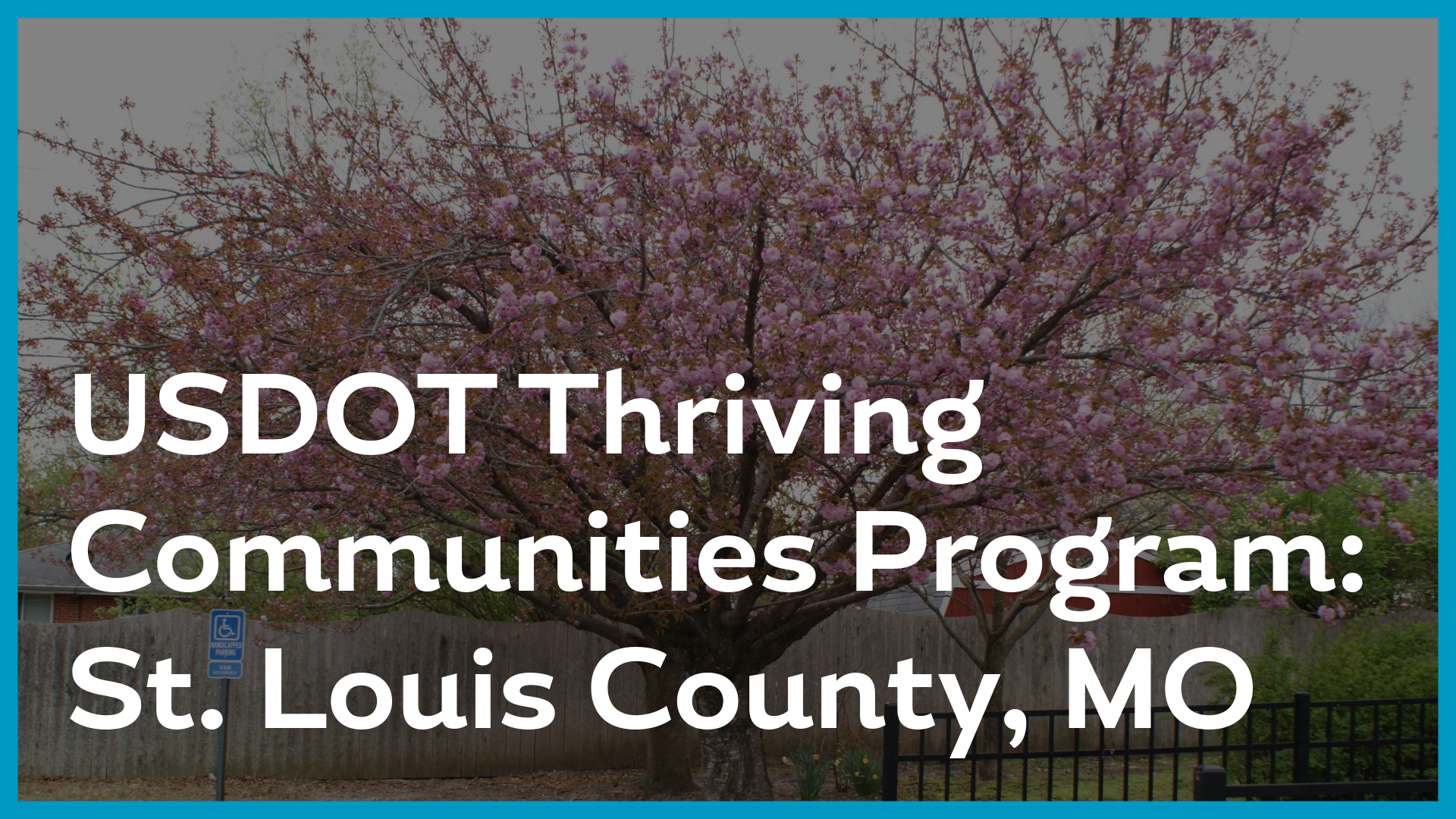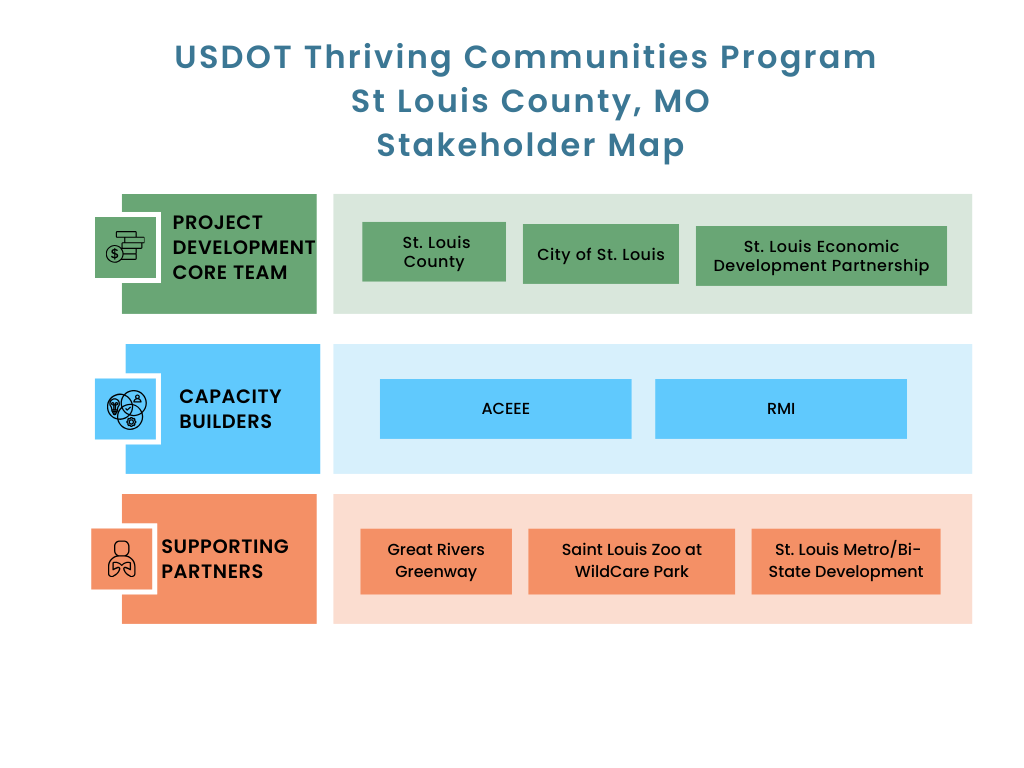Thriving Communities Program Establishes Strong Foundation for Community Development in Spanish Lake

Case Study: St. Louis Thriving Communities Program
St. Louis County was selected as one of just 15 communities nationwide to participate in the U.S. Department of Transportation’s Thriving Communities Program (TCP)—a highly competitive initiative designed to help under-resourced communities access federal infrastructure funding and implement community-led transportation and revitalization plans. Through this program, St. Louis Economic Development Partnership (STL Partnership) played a critical role, leading inclusive public engagement efforts and coordinating across agencies to ensure local voices helped shape transportation investments in the Spanish Lake community. The Mobility Learning Center (MLC) recently published a case study detailing the St. Louis TCP.
The TCP initiative successfully bridged coordination between St. Louis County, the City of St. Louis, and other local partners. It laid the groundwork for future collaboration and strategic investments—especially as the region prepares for the 2027 opening of the St. Louis Zoo’s WildCare Park, a transformative project expected to generate over $660 million in regional economic impact.
STL Partnership led two engagement events—at Twillman House in Spanish Lake and Chain of Rocks Park in North City—to gather input directly from residents. Key takeaways included improvements for Bellefontaine Road, where residents called for action on speeding, retail vacancies, and sidewalk improvements, and expressed interest in public art and community spaces. Along Riverview Drive, community members highlighted safety concerns, flooding, and the lack of pedestrian and bicycle infrastructure.
There were four targeted activities TCP used to ensure that the impact of WildCare Park will be synergistic with the community and improvements to transportation within the location will be led through collaboration with public agencies. These were informed by the public engagement efforts in the Spanish Lake area led by STL Partnership.
The first activity was a corridor study for Riverview Drive, led by CBB, a local multidisciplinary transportation planning and engineering firm. The team met with over two dozen representatives throughout the community and local public agencies and discussed the results of this study and possible implementation strategies. They assessed flooding risks and identified safety and multimodal access concerns.
The outcome of the study was St. Louis County applying for East-West Gateway Great Streets Initiative. If awarded, this planning grant would detail corridor redesign required to receive federal funding to implement improvements.
Another activity was a refocusing on the 2021 Spanish Lake Town Center Master Plan. This was looked at through a new lens to determine implementation through a coordinated approach. ACEEE, a nonprofit research organization that develops policies to reduce energy waste and combat climate change, led a review of the plan and proposed recommendations to Bellefontaine Road.
The resulting recommendations were improvements to support walkability, reduce speeding, and attract new businesses.
A comprehensive meeting between St. Louis County, St. Louis Metro, and the St. Louis Zoo was brought together by the Capacity Builder team. The call highlighted areas for long-term planning and led to a better understanding of micro transit and public transit operations in Spanish Lake. The outcome of this engagement was a foundational blueprint to guide future transit decisions for this growing corridor.
In addition, a comprehensive effort was led to identify financing mechanisms to support these transportation investments across Spanish Lake, piloted by ACEEE. Funding tools include Community Improvement Districts (CIDs), Transportation Development Districts (TDDs), state/federal grants, and philanthropic support.
This research is charting next steps before WildCare Park’s opening in 2027, while the Spanish Lake Working Group, facilitated by STL Partnership in coordination with County Planning and Public Works and Transportation, will continue regular meetings to ensuring the continuation of these efforts.
The momentum built through TCP has already catalyzed several next steps. ST L Partnership will submit an application to the St. Louis County Port Authority requesting a cost-benefit analysis for a potential local taxing district (e.g., a TDD or CID) to support future infrastructure investments along Bellefontaine Road. Finally, the success of the TCP also helped the region to receive the Transforming Neighborhoods technical assistance from the National Association of REALTORS® in collaboration with The Counselors of Real Estate® (CRE). This program will focus more broadly on economic development opportunities in Spanish Lake and surrounding areas.
STL Partnership is proud to continue working alongside County and City partners to turn community priorities into action—and ensure that Spanish Lake benefits fully from new investments, both public and private. The TCP case study dives deeper into how partnerships, planning, and public input are driving change.
Read the full case study here.

Stakeholder Map. Credit: SUMC
